Book contents
- Frontmatter
- Contents
- List of contributors
- Foreword
- Part I Introduction to hemochromatosis
- Part II Genetics of hemochromatosis
- Part III Metal absorption and metabolism in hemochromatosis
- Part IV Diagnostic techniques for iron overload
- Part V Complications of iron overload
- Part VI Therapy of hemochromatosis and iron overload
- 31 Management of hemochromatosis
- 32 Chelation therapy in iron overload
- 33 Liver transplantation and hemochromatosis
- 34 Survival in hemochromatosis
- Part VII Infections and immunity in hemochromatosis
- Part VIII Hemochromatosis heterozygotes
- Part IX Relationship of hemochromatosis to other disorders
- Part X Animal models of hemochromatosis and iron overload
- Part XI Screening for hemochromatosis
- Part XII Hemochromatosis: societal and ethical issues
- Part XIII Final issues
- Index
34 - Survival in hemochromatosis
from Part VI - Therapy of hemochromatosis and iron overload
Published online by Cambridge University Press: 05 August 2011
- Frontmatter
- Contents
- List of contributors
- Foreword
- Part I Introduction to hemochromatosis
- Part II Genetics of hemochromatosis
- Part III Metal absorption and metabolism in hemochromatosis
- Part IV Diagnostic techniques for iron overload
- Part V Complications of iron overload
- Part VI Therapy of hemochromatosis and iron overload
- 31 Management of hemochromatosis
- 32 Chelation therapy in iron overload
- 33 Liver transplantation and hemochromatosis
- 34 Survival in hemochromatosis
- Part VII Infections and immunity in hemochromatosis
- Part VIII Hemochromatosis heterozygotes
- Part IX Relationship of hemochromatosis to other disorders
- Part X Animal models of hemochromatosis and iron overload
- Part XI Screening for hemochromatosis
- Part XII Hemochromatosis: societal and ethical issues
- Part XIII Final issues
- Index
Summary
Introduction
Hemochromatosis is one of the most frequent inborn errors of metabolism. Survival analyses in long-term studies show that, in the absence of hepatic cirrhosis and diabetes mellitus, iron removal by phlebotomy therapy prevents further tissue damage and is associated with a normal life expectancy. Patients with massive, long-lasting iron overload have a worse prognosis than those with less severe iron excess. It is probable that the duration and severity of iron overload determine the degree of tissue damage and thus the patient's prognosis. Iron removal, in general, ameliorates hepatic disease, weakness, and cardiac abnormalities, and also prevents the progression of endocrine alterations. Therapy, however, does not reverse arthropathy or insulin-dependent diabetes mellitus. Most deaths in patients with hemochromatosis are caused by hepatic cancer that often occurs years after completion of iron removal. In patients with hemochromatosis, hepatic cirrhosis, cardiomyopathy, and diabetes mellitus are also more frequent causes of death than in the general population. Further strategies have to evaluate the design of screening programs in order to diagnose more patients in the pre-cirrhotic and asymptomatic stage.
Therapy
The most important advancement in the management of hemochromatosis is phlebotomy therapy. In recent years, increasing attention has been paid to earlier diagnosis and treatment and, thus, to the prevention of irreversible tissue damage due to iron overload. Several long-term studies have evaluated the outcome in patients who were diagnosed in the pre-cirrhotic stage. It is unclear whether treatment of such patients prevents the development of hepatic cancer, a major cause of death in cirrhotic patients (even when their excessive iron has been removed).
- Type
- Chapter
- Information
- HemochromatosisGenetics, Pathophysiology, Diagnosis and Treatment, pp. 359 - 368Publisher: Cambridge University PressPrint publication year: 2000
- 1
- Cited by



